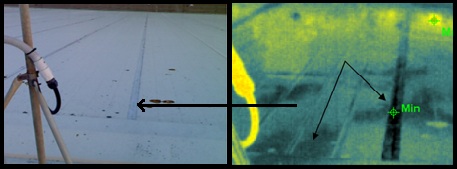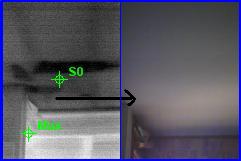Here is an infrared photo from a thermographic survey we did for one of the largest dairy companies in the world.
Thermal imaging cameras are an excellent tool for detecting moisture ingress into cold store panels.
We were recently hired to detect any signs of water leaking into a building freezer cool room made up entirely of 150mm thick polystyrene panels (poly in the middle and a plastic skin on either side). Between each panel is a join as seen in this image below.
(The darkest area is water under the sealant between the panels. The lighter shades is water under the panels)
In theory: The roof should be a uniform temperature across the entire surface, as there is no shade or obstructions that could cause a different infrared temperature reading in isolated areas. On this roof, there were thermal anomalies in several areas which indicates there could be moisture ingress inside the panels.
The reason we can detected these anomalies, is because the moisture inside the panels would heat up and cool down at a different rate to the rest of the panels where no moisture is present. Thermal imaging can detect such anomalies instantly.
Taking into account the cool stores are running below zero degrees, any water inside these panels will most likely freeze. Frozen water will lead to excess weight inside the panels, and will also cause loss of cold air by conduction.
Potential Danger: A large build up of ice inside a low pitch roof cavity which is only 150mm thick could cause the roof to collapse due to sudden increase in weight.
Time of Survey: Just as the sun went down to avoid reflection giving off false readings. We needed some daylight so we had a reference point in the still images. This infrared inspection should have been done from a cherry picker or helicopter for safety reasons, but the pitch of the roof was low and safe to walk on.
In summary: Further invasive testing should be carried out in random areas to confirm if moisture/ice is present, and to confirm the structural integrity of the roof area.









